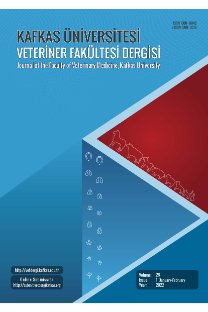Investigation of bacteriocin production capability of lactic acid bacteria ısolated from foods
katalaz, antimikrobiyal özellikler, bakteriyosin, laktik asit bakterileri, Listeria monocytogenes
Gıdalardan izole edilen laktik asit bakterilerilerinin bakteriyosin üretme yeteneklerinin araştırılması
catalase, antimicrobial properties, bacteriocins, lactic acid bacteria, Listeria monocytogenes,
___
- Daeschel MA: Antimicrobial substance from lactic acid bacteria for use as food preservatives. Food Technol, 43, 164-166, 1989.
- Jack RW, Tagg JR, Ray B: Bacteriocins of Gram-positive bacteria. Microbiol Rev, 59 (2): 171-200, 1995.
- Holzapfel WH, Geisen R, Schillinger U: Biological preservation of foods with reference to protective cultures, bacteriocins and food-grade enzymes. Review Int J Food Microbiol, 24 (3): 343-62, 1995.
- Abee T, Krockel L, Hill C: Bacteriocins: modes of action and potentials in food preservation and control of food poisoning. Int J Food Microbiol, 28, 169-185, 1995. Marshall WM, Cole WM: Methods for making kefir and fermented milks based on kefir. J Dairy Res, 52, 451-456,1985.
- Vanos V, Cox L: Rapid routine method for the detection of lactic acid bacteria among competitive flora. Food Microbiol, 3, 223-234, 1986.
- Kandler O, Weiss N: Regular, Nonsporing Gram positive rods. Genus Lactobacillus. In, Sneath PHA, Mair NS, Sharpe ME, Holt JG (Eds): Bergey’s Manual of Systematic Bacteriology. Vol. 2, Williams and Wilkins, Baltimore M D, 1208-1234, 1986.
- Schillinger U, Lücke FK: Antibacterial activity of Lactobacillus sake isolated from meat. Appl Environ Microbiol, 55 (8): 1901-1906, 1989.
- Lewus CB, Montville TJ: Detection of bacteriocins produced by lactic acid bacteria. J Microbiol Methods, 13, 145-150, 1991.
- Campos CA, Rodriquez O, Calo-Mata P, Prado M, Barros-Velazquez J: Preliminary characterization of bacteriocins from Lactococcus lactis, Enterococcus faecium and Enterococcus mundtii strains isolated from turbot. Food Res Intern, 39 (3): 356-364, 2006.
- Vignolo GM, Suriani F, Holgado APR, Oliver G: Antibacterial activity of Lactobacillus strains isolated from dry fermented sausages. J Appl Bacteriol, 75, 34-349, 1993.
- Bromberg R, Moreno I, Zaganini CL, Delboni RR, Olivera J: Isolation of bacteriocin-producing lactic acid bacteria from meat and meat products and its spectrum of inhibitory activity. Braz J Microbiol, 35, 137-144, 2004.
- Deraz SF, Karlsson EN, Hedstrom M, Andersson MM, Mattiasson B: Purification and characterisation of acidocin D20079, a bacteriocin produced by Lactobacillus acidophilus DSM 20079. J Biotechnol, 117 (4): 343-354, 2005.
- Equchi T, Kamınaka K, Shıma J, Kawamoto S, Mori K, Choi SH, Doi K, Ohmomo S, Ogata S: Isolation and
- characterization of enterocin SE-K4 produced by thermophilic enterococci, Enterococcus faecalis K–4. Biosci Biotechnol Biochem, 65 (2): 247-253, 2001.
- Schillinger U, Lücke FK: Identification of lactobacilli from meat and meat products. Food Microbiol, 4,199-208, 1987.
- Carr FJ, Chill D, Miada N: The lactic acid bacteria: A literature survey. Crit Rev Microbiol, 28 (4): 281-370, 2002.
- Hammes WP, Weiss N, Holzapfel W: The Genera Lactobacillus and Carnobacterium. In, Balows A, Truper HG, Dworkin M, Harder W, Schleifer KH (Eds): The Prokaryotes. 2nd ed., Springer-Verlag, New York, Vol.2, pp.1535-1594, 1992.
- Budde BB, Hornbaek T, Jacobsen T, Barkholt V, Koch AG: Leuconostoc carnosum 4010 has the potential for use as a protective culture for vacuum-packed meats: Culture isolation, bacteriocin identification, and meat application experiments. Int J Food Microbiol, 83 (2): 171-84, 2003.
- Yamato M, Ozaki K, Ota F: Partial purification and characterization of the bacteriocin produced by Lactobacillus acidophilus YIT 0154. Microbiol Res,158, 169-172, 2003.
- Kanatani K, Oshimura M, Sano K: Isolation and characterization of acidocin A and cloning of the bacteriocin gene from Lactobacillus acidophilus. Appl Environ Microbiol, 61 (3): 1061-1067, 1995.
- Schagger H: Tricine-SDS-PAGE. Protocol. Nature Protocols, 1, 16-22, 2006.
- Blum H, Beier H, Gross HJ: Improved silver staining of plant proteins, RNA and DNA in polyacrylamide gels. Electrophoresis, 8 (2): 93-99, 1987.
- Delves- Broughton J: Nisin as a food preservative. Food Australia, 57 (12): 525-527, 2005.
- Tahiri I, Desbiens M, Benech R, Kheadr E, Lacroix C, Thibault S, Ouellet D, Fliss I: Purification, characterization and amino acid sequencing of divergicin M35: A novel class IIa bacteriocin produced by Carnobacterium divergens M35. Int J Food Microbiol, 97 (2): 123-36, 2004.
- Todorov SD, Dicks LMT: Screening for bacteriocinproducing lactic acid bacteria from boza, a traditional cereal beverage from Bulgaria comparison of the bacteriocins. Process Biochemistry, 41, 11-19, 2006.
- Nissen-Meyer J, Holo H, Havarstein LS, Sletten K, Nes IF: A novel Lactococcal bacteriocin whose activity depends on the complementary action of two peptides. J Bacteriol, 174 (17): 5686-5692, 1992.
- Piard JC, Muriana PM, Desmazeaud MJ, Klaenhammer TR: Purification and partial characterization of lactacin 481, a lanthionine-containing bacteriocin produced by Lactococcus lactis subsp. lactis CNRZ 481. Appl Environ Microbiol, 58 (1): 279-284, 1992.
- Klaenhammer TR: Genetics of bacteriocins produced by lactic acid bacteria. FEMS Microbiol Rev, 12, 39-86, 1993.
- ISSN: 1300-6045
- Yayın Aralığı: 6
- Başlangıç: 1995
- Yayıncı: Kafkas Üniv. Veteriner Fak.
Mycozoonosis associated with ringworm of calves in Erzurum province, Turkey
Yunusemre ÖZKANLAR, MUSTAFA SİNAN AKTAŞ, EKREM KİREÇCİ
Organik süt sığırcılığında üretim maliyetleri ve karlılık açısından bir değerlendirme
ONUR ATAKİŞİ, EMİNE ATAKİŞİ, Tennur ATABAY, METEHAN UZUN
Effect of B - carotene on ovarium functions and ovsynch success in repeat breeder cows
Hacı Ahmet ÇELİK, GÜLCAN AVCI, İBRAHİM AYDIN, AZİZ BÜLBÜL, Tuğba BÜLBÜL
Ratlarda periferal kan hücreleri L-karnitin, arı sütü ve nar çekirdeğinin etkileri
Nejdet ŞİMŞEK, Ali KARADENİZ, ALEV GÜROL BAYRAKTAROĞLU
Cardiac troponin levels in dogs with dilate cardiomyopathy
Duygu ÇAKIROĞLU, YÜCEL MERAL, UTKU BAKIREL, Didem KAZANCI
Effcts of housing system and age on early stage egg production and quality in commercial laying hens
METİN PETEK, Fazlı ALPAY, Şerife Şule GEZEN, Recep ÇIBIK
Intrarenal segmentation of the renal arteries in the Kangal dog
DERVİŞ ÖZDEMİR, ZEKERİYA ÖZÜDOĞRU, İSMAİL MALKOÇ
Yunus GICIK, Murat KARA, BARIŞ SARI, Kemal KILIÇ, MÜKREMİN ÖZKAN ARSLAN
OKTAY ÖZKAN, Süleyman GÜL, Oya KELES, PINAR AKSU KILIÇLE, Taylan Özgür KAYA, GÖKHAN NUR
